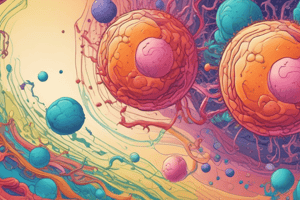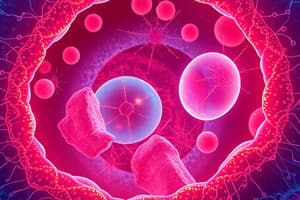Podcast
Questions and Answers
What is the function of vacuoles?
What is the function of vacuoles?
- Storage
- Regulation of cell volume
- Degradation of macromolecules
- All of the above (correct)
What are the functions of the central vacuole in plants?
What are the functions of the central vacuole in plants?
Storage of pigments, maintenance of turgor pressure, and water storage
Which of these groups of organisms have prokaryotic cells?
Which of these groups of organisms have prokaryotic cells?
- Bacteria (correct)
- Fungi
- Archaea (correct)
- Eukaryotes
What is a granum?
What is a granum?
What is the stroma?
What is the stroma?
What is the thylakoid lumen?
What is the thylakoid lumen?
What are microtubules?
What are microtubules?
What are vacuoles?
What are vacuoles?
Which of the following structures are part of the endomembrane system?
Which of the following structures are part of the endomembrane system?
What does systems biology refer to?
What does systems biology refer to?
Flashcards are hidden until you start studying
Study Notes
Vacuoles
- Functions include storage, regulation of cell volume, and degradation of macromolecules.
- In plants, the central vacuole specifically aids in storing pigments, maintaining turgor pressure, and storing water.
Cell Types
- Prokaryotic cells are found in bacteria and Archaea, characterized by the absence of a membrane-bound nucleus and organelles.
Cellular Structures
- Granum: A stack of thylakoids, crucial for photosynthesis in chloroplasts.
- Stroma: The fluid-filled space within chloroplasts, surrounding the thylakoid membranes, involved in the Calvin cycle.
- Thylakoid Lumen: The compartment within thylakoids, where light-dependent reactions take place.
Microtubules
- Composed of tubulin proteins, microtubules are long, hollow, cylindrical structures approximately 25 nm in diameter, essential for maintaining cell shape and facilitating intracellular transport.
Vacuoles
- Specialized cellular compartments filled with fluids and sometimes solids, playing roles in storage and maintaining homeostasis.
Endomembrane System
- Includes integral structures such as the Golgi apparatus, lysosomes, endoplasmic reticulum, and the nuclear envelope, interacting within the cell for various functions.
Systems Biology
- An approach focusing on studying organisms through the interactions of their components, rather than analyzing each component in isolation, providing insight into their complex behaviors and functions.
Studying That Suits You
Use AI to generate personalized quizzes and flashcards to suit your learning preferences.




